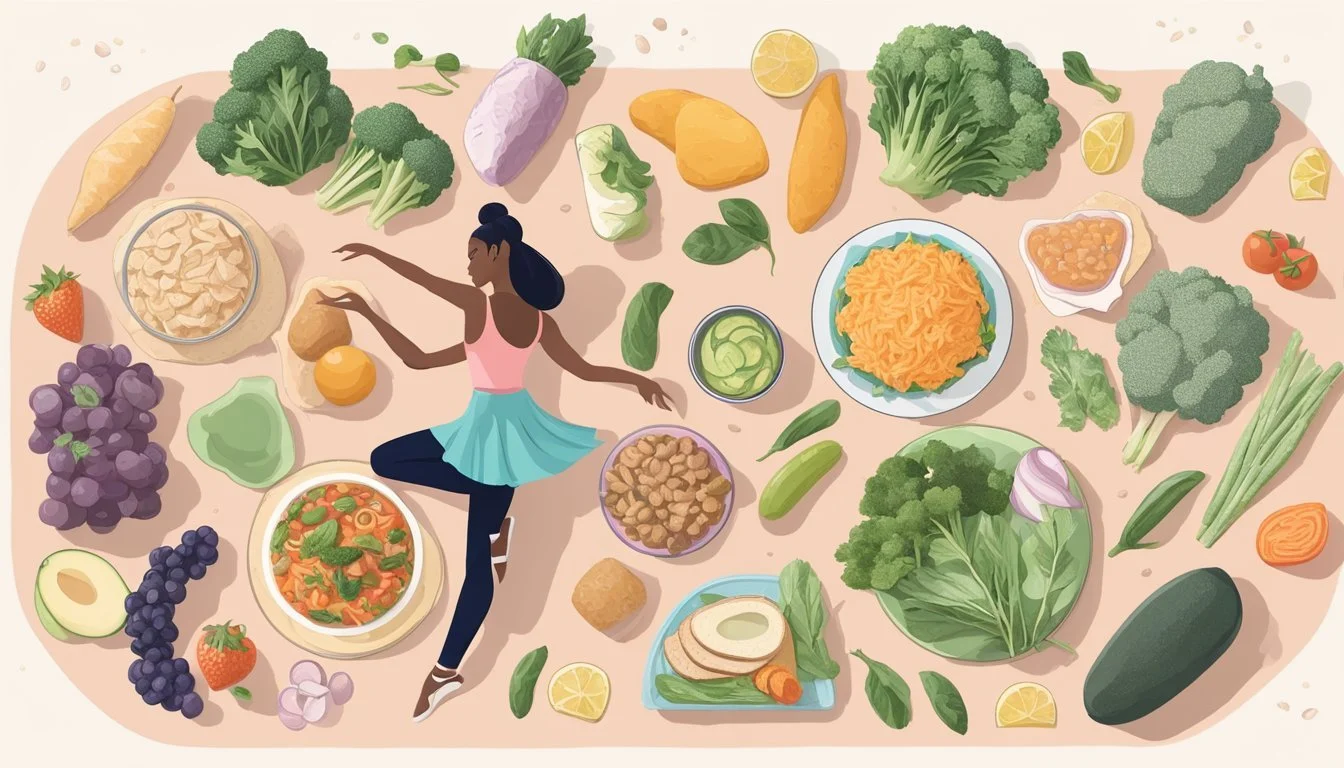Keto Diet for Dancers
Optimizing Performance and Stamina
The ketogenic, or keto, diet is a high-fat, low-carbohydrate eating plan that has been adopted by many seeking various health benefits. It heavily restricts carbohydrates to usually less than 50 grams per day, pushing the body into a state of ketosis, where fat becomes the primary source of energy instead of glucose from carbs. This diet's popularity spans across various lifestyles, and recently, it has sparked interest within the dance community as performers continually seek optimal nutrition to maintain peak performance levels.
For dancers, managing energy effectively is crucial, as their art demands high endurance, strength, and concentration. The traditional dancer's diet includes a balance of macronutrients, including carbohydrates, which serve as a fast-acting fuel source for rigorous training and performance. As such, the keto diet's stringent carb limitations raise questions within the dance community regarding its suitability and impact on a dancer's energy availability, muscle function, and overall health.
Nutritional strategies are deeply personal and often tailored to an individual's specific needs, especially in professions such as dance that require both physical prowess and artistic expression. While some anecdotal evidence suggests benefits like increased energy and decreased inflammation, dancers considering the keto diet must weigh these potential benefits against the need for readily available energy from carbohydrates and possible nutrient deficiencies. Professional advice from dietitians and health practitioners is crucial when a dancer deliberates altering their diet in such a significant manner.
Understanding the Keto Diet
The keto diet is a metabolic strategy centered on the consumption of high-fat, low-carb foods, leading to a state of ketosis, where fat becomes the primary source of energy.
Principles of Ketogenesis
Ketogenesis occurs when the body utilizes fat instead of carbohydrates for energy. The shift happens due to carbohydrate restriction, forcing the body to deplete its glycogen stores and turn to fatty acids and ketone bodies as primary energy sources.
Macronutrient Distribution
The ketogenic diet recommends a specific division of macronutrients:
Fat: 70-80% of total daily calories
Protein: Moderate intake, typically 20-25%
Carbohydrates: Limited to 5-10%
This distribution ensures the body remains in a state of ketosis, optimizing fat as the main fuel source.
Ketosis and Metabolism
Ketosis is a metabolic state where the body's energy supply comes from ketone bodies in the blood, in contrast to glycolysis, where blood glucose provides energy. Achieving ketosis depends on adhering to the strict macronutrient ratio of high-fat and low-carbohydrate intake, thereby altering the body's normal metabolic pathway.
Keto Diet Benefits for Dancers
Exploring a ketogenic diet might offer dancers specific advantages, such as effective weight management and a shift in energy sources that could influence performance and cognition.
Weight Management
When dancers switch to a ketogenic diet, their bodies begin to utilize fat for fuel, which can aid in weight management. This shift may help dancers maintain or achieve a desired body composition. However, it's essential for them to closely monitor their dietary intake to ensure they're getting the necessary nutrients.
Enhanced Metabolic Efficiency
A ketogenic diet may enhance metabolic efficiency by teaching the body to burn fats instead of carbohydrates. This could lead to less fatigue during long rehearsals or performances as dancers' bodies become adapted to using a more sustained energy source—dietary fats.
Cognitive Advantages
Some dancers on a ketogenic diet have reported improved mental clarity and focus, which are vital for rehearsing complex choreographies and maintaining high levels of concentration during performances. These cognitive benefits could be attributed to the stable blood sugar levels that a diet high in fats and low in carbs can provide.
Nutritional Considerations
When considering the ketogenic diet for dancers, one must ensure that they maintain a balance of essential micronutrients, optimal hydration, and gut health through adequate fiber intake, given their high-energy demands.
Essential Micronutrients
Dancers require a diverse range of micronutrients to support their rigorous activity levels. The restriction of carbohydrates on a ketogenic diet typically leads to a lower intake of fruits and vegetables, which are vital sources of vitamins and minerals. Potassium, for instance, is crucial for muscle function and can be found in leafy greens, nuts, and avocados. They should also seek alternative sources for other micronutrients that are commonly found in carbohydrate-rich foods.
A quick guide for micronutrient-rich keto-friendly foods:
Sodium & Potassium: Avocados, leafy greens, nuts
Calcium & Magnesium: Seeds, cheese, fish
Vitamins A, C, and E: Bell peppers, spinach, almonds
Optimal Hydration
Optimal hydration is critical for dancers, who lose fluids rapidly through sweat during rigorous practice and performance. A ketogenic diet can initially lead to a decrease in water retention, making hydration even more crucial. Electrolytes, which are minerals in your blood and other body fluids that carry an electric charge, are lost in sweat and must be replenished to avoid dehydration and the risk of muscle cramps.
Key electrolytes include:
Sodium
Potassium
Magnesium
Calcium
Dancers on a ketogenic diet should drink plenty of water and may benefit from electrolyte supplements or electrolyte-rich bone broths.
Gut Health and Fiber Intake
A common challenge for those on a ketogenic diet, including dancers, is to ensure they receive enough fiber to prevent constipation and maintain overall gut health. As high-carbohydrate foods such as whole-grain bread and cereals are often limited on a ketogenic diet, it is important to include fiber-rich, low-carb vegetables and seeds.
Fiber sources for a ketogenic diet:
High-fiber vegetables: Broccoli (how long does broccoli last?), cauliflower
Seeds: Chia seeds, flaxseeds
Nuts: Almonds, walnuts
Including these high-fiber, keto-friendly foods can help maintain gut health, aid in digestion, and provide a slow, steady release of energy.
Foods to Include and Avoid
A dancer's keto diet centers around precise food choices to help maintain energy while promoting fat burning. Here's what to include and what to steer clear of.
Fiber-Rich Vegetables
Vegetables on a keto diet should be low in carbs but high in fiber. Dancers can include leafy greens like spinach, kale, and lettuce, which are nutrient-dense and supportive of digestive health.
Include:
Spinach
Kale
Lettuce
Broccoli
Cauliflower
Limit:
Potatoes
Corn
Peas
Carrots
Quality Fats and Proteins
Dancers should focus on consuming healthy fats and high-quality proteins. Monounsaturated fats like olive oil and avocados are excellent choices. For proteins, lean options such as chicken breast, fish, and seafood are preferred to sustain muscle repair and energy.
Healthy Fats:
Olive oil
Avocados
Nuts
Seeds
Proteins:
Chicken breast
Fish like salmon and tuna
Beef (select leaner cuts)
Eggs
Restricted Items
To stay in ketosis, dancers must limit or avoid foods high in carbohydrates. This includes traditional sources of energy like bread, pasta, and sugary fruits. They should also be cautious with their intake of certain dairy products and processed animal products.
Avoid:
Bread
Pasta
Rice
High-sugar fruits (bananas, grapes)
Processed snacks
Limit:
Milk
Yogurt
Cheeses high in carbs
Customizing Keto for Dancers
For dancers considering a ketogenic diet, it is crucial to tailor the approach to meet the high energy demands of their physical activity. Strategic modification and understanding of macronutrients can help in minimizing potential negative side effects, such as the 'keto flu'.
Keto Diet Variations
A standard ketogenic diet involves high fat intake and low carbohydrates, typically with a macronutrient ratio of about 70% fats, 25% protein, and only 5% carbohydrates. However, dancers require an adjustment of these ratios to sustain their rigorous physical activity. Variations such as the Cyclical Ketogenic Diet (CKD), where individuals follow the standard keto diet for a few days followed by a couple of days of higher carb intake, can help in maintaining energy for performance and training days.
Balancing Macronutrients
It is essential for dancers on a keto diet to balance macronutrients diligently to support energy needs without disrupting the state of ketosis. More specifically:
Fats: Aim for quality sources like avocados, nuts, and seeds that provide sustained energy.
Proteins: Opt for lean proteins such as chicken, turkey, fish, and plant-based options to aid muscle repair.
Carbohydrates: Carefully select nutrient-dense, fibrous carbs such as leafy greens, which have minimal impact on ketosis.
Here's a concise macronutrient guide for dancers personalizing a ketogenic diet:
Macronutrient Purpose Examples Fat Main energy source on keto; sustains long-duration activities Avocados, nuts, seeds Protein Supports muscle maintenance and repair Lean meats, legumes Carbohydrates Provides quick energy and helps in recovery on targeted days Leafy greens, fibrous vegetables
Adaptation Period
Dancers beginning a ketogenic diet may experience an adaptation period, commonly known as the 'keto flu', where symptoms like fatigue, headaches, and irritability occur. This temporary phase typically lasts anywhere from a few days to a couple of weeks. Gradually decreasing carbohydrate intake can help the body adjust more smoothly. Monitoring the balance of electrolytes with sufficient intake of sodium, potassium, and magnesium is also beneficial during this transition period.
Potential Health Concerns
The ketogenic diet may pose several health concerns for dancers, who require consistent energy levels and muscular endurance. Specific side effects and the implications for cardiac and skeletal health are considerations that should be assessed carefully.
Short and Long-Term Side Effects
Individuals on the ketogenic diet may experience a range of short-term side effects such as dehydration due to reduced glycogen stores and increased diuresis. Dancers might find this particularly challenging due to their high-intensity workouts and need for hydrating to maintain performance. Long-term side effects are a subject of ongoing research, but concerns include the potential for increased cholesterol levels, which may lead to heart disease, and acidosis from sustained ketosis.
Monitoring Heart and Bone Health
Cholesterol levels can fluctuate significantly on a ketogenic diet. While some individuals see an improvement, others might experience a rise in LDL ("bad") cholesterol. This could increase the risk of heart disease, an important consideration for anyone engaged in a physically demanding profession like dance. Additionally, due to limited intake of certain nutrients, dancers should be vigilant about bone health; a keto diet can sometimes lead to reduced bone density and therefore an increased risk of fractures.
Dealing with Keto Flu and Fatigue
The transition to a ketogenic diet often triggers the keto flu, characterized by symptoms such as fatigue, headaches, and irritability. These symptoms result from the body adapting to burning fat for fuel instead of carbohydrates. Such effects may impair a dancer's ability to train or perform. Constant energy levels are critical for dancers, and fatigue can have a considerable impact on their physical capabilities and overall well-being.
Consulting Healthcare Professionals
When dancers consider dietary changes like the keto diet, it is essential they seek guidance from healthcare professionals. Expert advice ensures they meet their unique nutritional needs while maintaining peak performance.
Registered Dietitian Nutritionists
Registered Dietitian Nutritionists (RDNs) are healthcare professionals specifically trained in nutrition. Dancers should consult with RDNs to:
Personalize Nutrition: Tailor a diet that complements their demanding physical routine.
Screen for Deficiencies: Identify and rectify potential nutrient shortfalls that could impair performance.
Manage Health: Address any existing health concerns, including disordered eating patterns, which can be affected by dietary changes.
RDNs hold a credential issued by the Commission on Dietetic Registration, ensuring that the dietitian has met specific professional prerequisites and maintains continued competency through ongoing education.
Certified Sports Nutrition Specialists
Certified Specialists in Sports Nutrition (CSSNs) possess expertise in nutrition for athletic performance. For dancers exploring a keto diet, CSSNs can:
Optimize Energy: Develop meal plans that support sustained energy levels for rigorous dance routines.
Enhance Recovery: Recommend strategies to aid in the repair and rejuvenation of muscles post-performance.
Boost Strength: Advise on nutritional tactics to build and maintain muscle mass integral to a dancer's athleticism.
Seeking the guidance of a CSSN helps ensure that an athlete's diet is conducive to their sport-specific demands. They have certified credentials through programs accredited by the National Commission for Certifying Agencies, which validate their specialized knowledge in sports nutrition.
Keto Recipes and Meal Planning
When dancers tailor their meal plans, it is crucial to focus on keto-friendly recipes that cater to their unique nutritional and energetic needs, ensuring they are easy to prepare and suitable for on-the-go consumption.
Easy-to-Prepare Meals
Breakfast: A dancer's morning meal might include scrambled eggs with spinach and a side of avocado. The eggs provide protein, while the avocado offers healthy fats essential for sustained energy.
Lunch: Grilled chicken salad with mixed greens, a good handful of nuts, and full-fat cheese dressed in olive oil serves as a balanced meal, offering both nutrients and convenience.
Dinner: After a day of rehearsals, a one-pan dish like salmon and roasted vegetables can be both satiating and simple. A mix of broccoli, cauliflower, and bell peppers provides low-carb variety.
Snacks on the Go
Nuts and Seeds: A small bag of almonds or pumpkin seeds is portable and filled with fats and protein.
Cheese: String cheese or cheese cubes are keto-friendly and can be easily packed for a dance competition or practice.
Pre and Post Rehearsal Foods
Pre-Rehearsal: A smoothie made from coconut milk, a handful of berries, and protein powder can offer a quick energy boost.
Post-Rehearsal: Dancers often need a replenishing snack such as a hard-boiled egg or slices of turkey breast wrapped around cheese sticks, which aids muscle recovery.
Addressing Common Misconceptions
When it comes to the keto diet for dancers, it’s crucial to dissect the myths and facts for better understanding of its impact on health and performance.
Keto and Athletic Performance
Myth: Keto enhances performance by turning fat into the primary energy source.
Fact: While the body may burn fat on a ketogenic diet, studies show that for high-intensity activities like dance, carbohydrates are a more efficient fuel source. A dancer's demanding schedule may not align with the initial energy slump that accompanies the transition to ketosis, potentially hindering performance.
Fat Intake and Health Risks
Unsaturated fats vs. Saturated fats:
Unsaturated Fats: These are often found in plants and fish and are associated with health benefits when they replace saturated fats in the diet.
Saturated Fats: Commonly found in animal products and may increase health risks if consumed in excess.
Fact: The keto diet's high fat requirement does not differentiate between saturated and unsaturated fats. For dancers, excessive intake of saturated fats can pose long-term health risks, rather than offering the cardiovascular health benefits that unsaturated fats provide.
Sustainability of Keto Diet
Long-Term Health:
The ketogenic diet's restrictiveness can make it difficult for dancers to maintain a balanced diet and can lead to deficiencies in essential nutrients.
Performance:
Physical Activity: The body’s need for quick energy during dance could be at odds with the slow energy release from fats.
Myths and Facts: The belief that keto will consistently improve a dancer's performance is a myth not supported by evidence; rather, a balanced diet tailored to an individual's specific needs is more likely to sustain physical activity and long-term health.
Lifestyle and Social Considerations
Adopting a keto diet as a dancer not only affects one's physical performance but also has social and mental health implications. The intricate balance of maintaining stringent dietary requirements with a vibrant social life, the potential impact on mental well-being, and the influences of prevalent diet trends play significant roles in a dancer’s lifestyle.
Balancing Diet with Social Life
When a dancer opts for a keto lifestyle, social gatherings can become challenging, given the dietary restrictions. Tips for navigating these events include:
Communicate with Hosts: Advance communication with event hosts to inquire about keto-friendly options.
Be Prepared: Bringing one's own snacks or meals to ensure adherence to the diet can be useful.
It's important for dancers to feel confident in explaining their dietary choices without pressure to conform to the norm.
Impact on Mental Health
The keto diet's restrictive nature may lead to feelings of anxiety or isolation in social settings, which can, in turn, affect mental health. Findings suggest:
The necessity for balanced dietary approaches that prioritize both physical and emotional well-being.
Awareness of signs of eating disorders, which dancers are at increased risk for, given the aesthetic demands of their profession.
Strategies should involve artist development programs that support healthy nutrition and mental health resources.
Navigating Diet Trends
Dancers may feel compelled to follow diet trends prevalent in the media, including those promoted on social media platforms. A practical approach involves:
Assessing the sustainability and impact of a diet on long-term health and performance.
Ensuring that dietary choices are informed by credible sources and tailored to the dancer’s individual needs.
It's essential that dancers maintain an informed perspective, avoiding impulses to adopt new diets without thorough evaluation.






